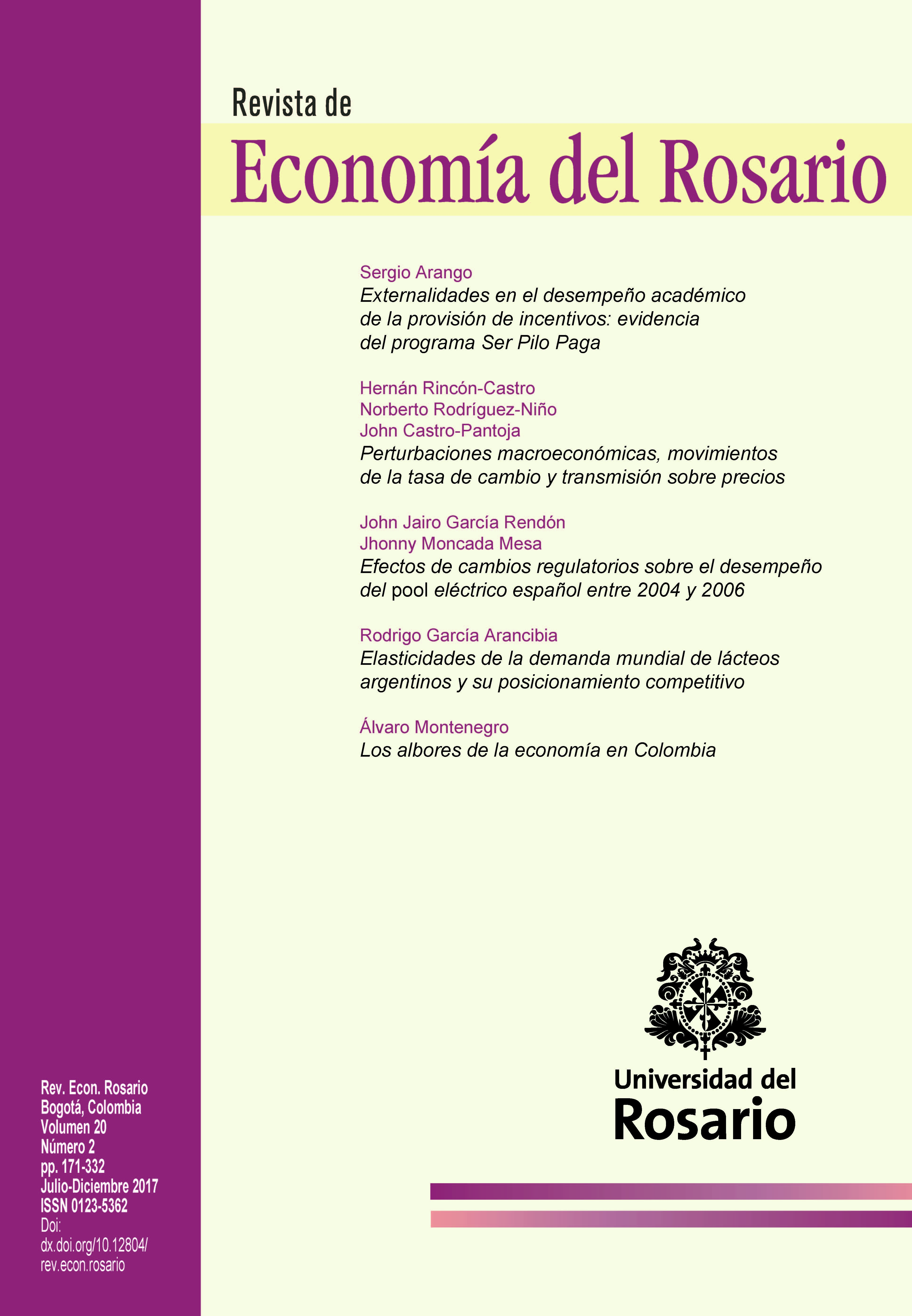Externalidades en el desempeño académico de la provisión de incentivos: evidencia del programa Ser Pilo Paga
Barra lateral del artículo
Contenido principal del artículo
En octubre de 2014 el Gobierno colombiano anunció la provisión de 10 000 becas a estudiantes de bajos recursos para estudiar en instituciones de educación superior. En este trabajo, se estima el efecto ser elegible por el programa en colegios con y sin beneficiarios de este luego de la primera ola de incentivos, sobre los resultados del examen Saber 11 de los estudiantes que presentaron la prueba en el 2015. Usando un modelo de diferencias en
diferencias se encuentra que los estudiantes elegibles en colegios con beneficiarios aumentaron su puntaje global del examen y su puntaje en lectura en 0,03 desviaciones estándar, mientras que en matemáticas el aumento fue de 0,02 desviaciones estándar. En colegios sin beneficiarios, ser elegible representó un aumento de 0,09 desviaciones estándar en el puntaje global del examen y en matemáticas, mientras que en lectura el aumento fue de 0,08 desviaciones estándar. Estos resultados sugieren la existencia de externalidades en los estudiantes de colegios que no obtuvieron beneficiarios del programa en la primera entrega de incentivos.
Descargas
Acemoglu, D., & Angrist, J. (2000). How Large are Human Capital Externalities? Evidence from Compulsory Schooling Law. NBER Macroeconomics Annual, 15, 9-59.
Angrist, J., & Lavy, V. (2009). The Effect of High-Stakes High School Achievement Awards: Evidence from a School-Centered Randomized Trial. American Economic Review, 99, 1384-1414.
Angrist, J., Lang, D., & Oreopoulos, P. (2009). Incentives and Services for College Achievement: Evidence from a Randomized Trial. American Economic Journal: Applied Economics, 1(1), 136-163.
Bettinger, E. (2012). Paying to Learn: The Effect of Financial Incentives on Elementary School Test Scores. The Review of Economics and Statistics, 94(3), 686-698.
Camacho, A., Messina, J., & Uribe, J. P. (2016). The Expansion of Higher Education in Colombia. Bad Students or Bad Programs? IDB Discussion Paper 452.
Camerer, C., & Hogarth, R. (1999). The Effects of Financial Incentives in Experiments: A Review and Capital-labor-production Framework. Journal of Risk and Uncertainty, 19, 7-42.
Chetty, R., Friedman, J., Hilger, N., Saez, E., Whitmore, D., & Yagan, D. (2010). How Does your Kindergarten Classroom Affect your Earnings? The Quarterly Journal of Economics (en prensa).
Chetty, R., Friedman, J., & Rockoff, J. (2014). Measuring the Impact of Teachers II: Teacher Value-Added and Student Outcomes in Adulthood. American Economic Review, 104(9), 2633-2679.
Contrato Interadministrativo 077 de 2015 de entre el Ministerios de Educación Nacional y el Instituto Colombiano de Crédito Educativo y Estudios Técnicos en el Exterior “ICETEX”.
Convenio Interadministrativo 711 de 2014 entre el Ministerios de Educación Nacional y el Instituto Colombiano de Crédito Educativo y Estudios Técnicos en el Exterior “ICETEX”.
Espinosa, F., Flórez, C., & Sánchez, L. (2008). Diseño del Índice Sisbén en su Tercera Versión-Sisbén III. Departamento Nacional de Planeación.
Galvis, C. (2014). Estadísticas de Educación Superior. Bogotá: Ministerio de Educación Nacional.
Gneezy, U., Mier, S., & Rey-Biel, P. (2011). When and Why (Don’t) Work to Modify Behavior. Journal of Economic Perspectives, 25(4), 191-210.
Greene, D., & Lepper, M. (1974). Effects of Extrinsic Rewards on Childrens Subsequent Intrinsic Interest. Child development, 34, 1141-1145.
Greene, D., Sternberg, B., & Lepper, M. (1976). Overjustification in a Token Economy. Journal of personality and social psychology, 34, 1219-1234.
Hanushek, E. (1997). Outcomes, incentives and beliefs: Reflections on Analysis of the Economics of Schools. Educational Evaluation and Policy Analysis, 19(4), 301-308.
Hanushek, E. (2003). The Failure of Input-Based Schooling Policies. Economic Journal, 113(485), 64-98.
Heller, D., & Marin, P. (2002). Who Should We Help? The Negative Social Consequences of Merit Scolarships. Los Ángeles: Harvard Civil Rights Project.
Jensen, R. (2010). The (Perceived) Returns to Education and the Demand for Schooling. The Quarterly Journal of Economics, 125(2), 515-548.
Koenker, R., & Hallock, K. (2001). Quantile Regression. Journal of Economic Perspectives, 15(4), 143-156.
Kremer, M., Miguel, E., & Thornton, R. (2009). Incentives to learn. The Review of Economics and Statistics, 91(3), 437-456.
Laajaj, R., Moya, A., & Sánchez, F. (2017). Motivational Effects of a Nationwide Merit Scholarship Program for Low Income Students. Bogotá: Universidad de los Andes.
Lepper, M. (1973). Undermining Children’s with Extrinsic Rewards. A Test of the Overidentification Hypothesis. Journal of Personality and Social Psychology, 28(1), 129-137.
Levitt, S., List, J. Neckermann, S., & Sadoff, S. (2016). The Behavioralist Goes to School: Leveraging Behavioral Economics to Improve Educational. Performance American Economic Journal: Economic Policy, 8(4), 183-219.
Londoño, J. (2016). Diversity and Redistributive Preferences: Evidence from a Quasi-Experiment in Colombia. Berkeley: University of California.
Londoño, J., Rodríguez, C., & Sánchez, F. (2017). The Intended and Unintended Impacts of a Merit-Based Financial Aid Program for the Poor: The Case of Ser Pilo Paga. Bogotá: Universidad de los Andes.
Lucas, R. (1988). On the Mechanics of Economic Development. Journal of Monetary Economics, 22, 3-42.
MacLeod, B., Riehl, E., Saavedra, J., & Urquiola, M. (2017). The Big Sort: College Reputation and Labor Market Outcomes. American Economic Journal: Applied Economics, 9(3), 223-261.
Nguyen, T. (2008). Information, Role Models and Perceived Returns to Education: Experimental Evidence from Madagascar. MIT Working Paper.
OECD, International Bank for Reconstruction and Development & The World Bank (2012). Reviews of National Policies for Education: Tertiary Education in Colombia. S.d.: oecd Publishing. doi http://dx.doi.org/10.1787/9789264180697-en



